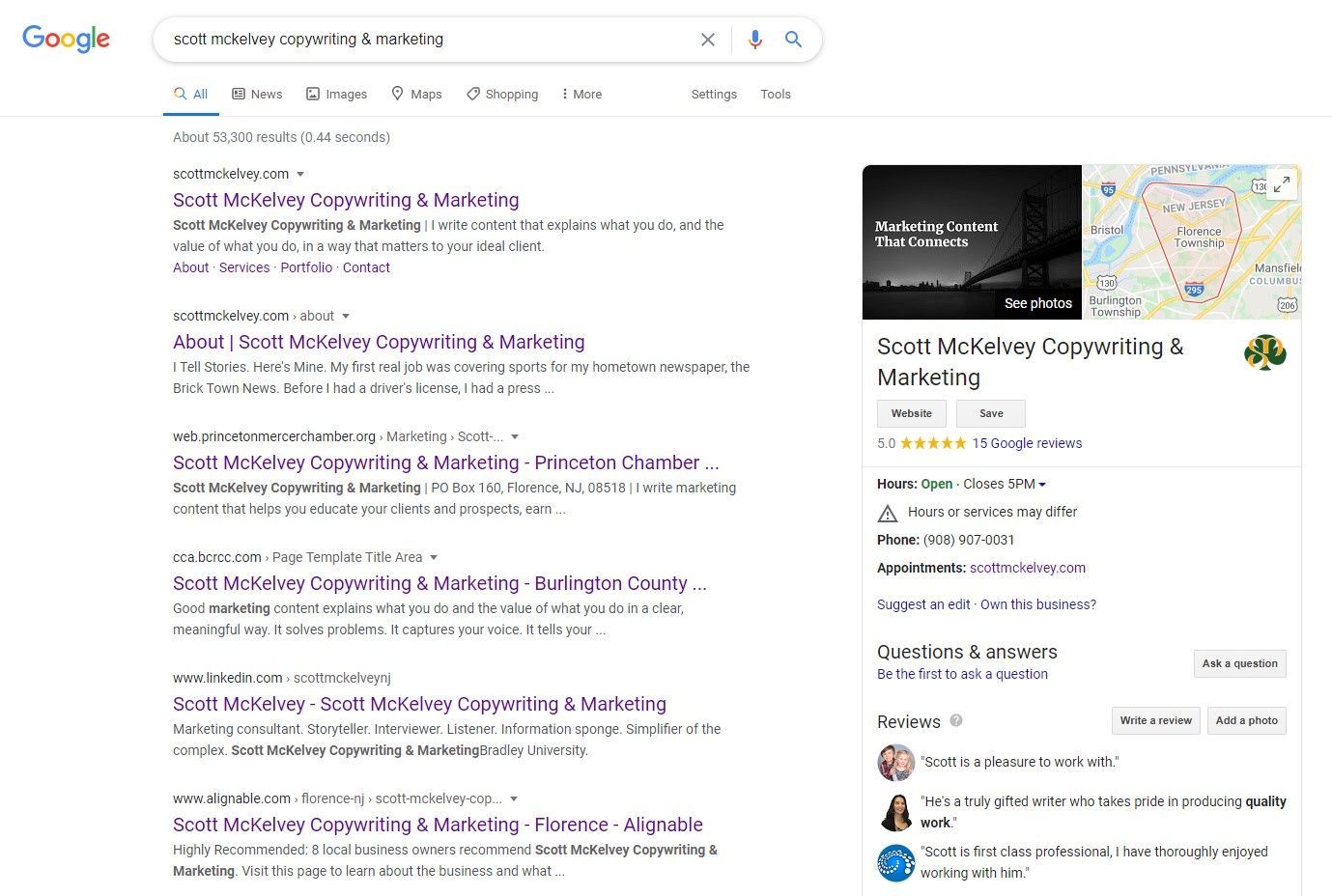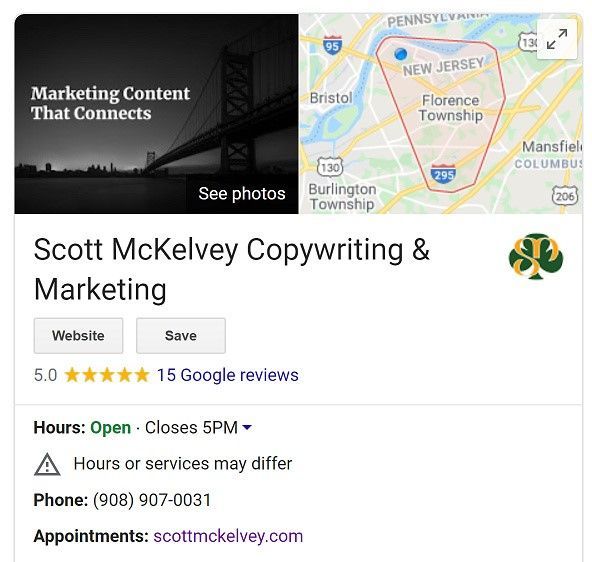Office, Store, or Home-Based, Every Organization Needs a Google My Business Profile

I’ve been working from home for the better part of the last 13 years – a trailblazer, I guess – and running my own business from home for the last seven years.
I used to think Google My Business (formerly Google Local and Google Places) was only for companies that have a physical location. During the early years of this platform, I’m pretty sure that was the case, although I haven’t been able to confirm this.
Fast forward to today and Google My Business can and should be used by any company or nonprofit, whether you have an office or store or work from home.
I say this as a person who’s always hesitant to jump through hoops because Google said so. But Google My Business isn’t just about Google and it doesn’t require you to jump through hoops.
For example, this isn’t Google+. We all knew Google+ was a virtual wasteland that existed separate from popular Google services, but we created a profile anyway. It was a free and easy way to feed the Google monster and possibly boost search rankings.
Google My Business is different. Your profile is embedded in Google search results and integrated with popular Google services like Google Maps and Google Reviews. Claiming and verifying your Google My Business listing and creating a profile is free and probably easier than Google+.
In this article, I’m not discussing how to get started with Google My Business. There are plenty of “how to” articles and videos to help you get going. I’d like to focus on the value Google My Business can provide to small businesses and nonprofits.
Google My Business is more than a free tool that helps people find you and do business with you. It gives you a huge chunk of prime real estate in Google search results and allows you to control and manage the information that Google shares about your organization.
Prime Real Estate on Google
Google used to be the platform that directed you to the information you wanted. Today, Google wants to be the source of as much information as possible.
That’s why the Google knowledge panel – that section on the right side of Google search results where the information from your Google My Business profile is displayed – takes up such a large chunk of prime Google real estate.

In a nutshell, Google wants to be your Home page.
In a perfect Google world, you won’t have to go to a website. Everything you need is right there on Google – location, contact information, hours of operation, photos, videos, reviews, information about events and special offers, etc.
Of course, this won’t be the case for every business or nonprofit. A new prospect might need deeper information before they contact you. They can click the “Website” button that’s prominently displayed at the top of your Google knowledge panel.
But if someone wants to get a phone number or directions, buy tickets, see a menu, schedule an appointment, donate, ask a question, or see photos and videos of your work, they can do those things and more from Google.
Either way, having this kind of visibility on Google is a big deal. It’s like free advertising on the most visited website in the world. More visibility translates to more business leads.
Staking claim to this real estate to enhance your online presence also gives you credibility as a legit business or nonprofit. The more information and value you provide through your Google My Business profile, the more credibility you’ll have in the eyes, hearts, and minds of Google users.
Control What Google Says About You
With Google My Business, Google is giving you the choice to publish and control the information it shares about your business or nonprofit. For many organizations that choose not to create a profile, Google will publish information anyway. They’ll just get it from other “reliable” sources and piece together a profile.
If that information isn’t coming directly from you, how do you know it’s 100 percent accurate and up to date?
Will it show an old phone number or logo? Will it show your winter hours instead of your summer hours? Will it show a product or service you no longer offer while leaving out a product or service you do offer? Will important information be left out?
If someone tries to use bad information and finds out it’s wrong, they won’t blame Google. They’ll blame you. And it could cost you that’s person’s business or donation.
Google My Business makes it easy to publish and control information. It makes it easy to promote events, special offers, and updates about your organization. In fact, you can publish up to 10 Google Posts, or updates, simultaneously. I’ve used Google Posts to share blog articles and promote my recent webinar.
Google My Business makes it easy to update basic details, like hours of operation and contact information. You might take this kind of information for granted, but it could be changing more often this year than you would have expected due to the pandemic.
Google My Business makes it easy to monitor and respond to Google Reviews that are critical to managing your brand reputation. It allows you to quickly diffuse a negative review and show that you value and pay attention to feedback.
I never had any Google Reviews before I created a Google My Business profile less than a year ago. Since I started asking for reviews as part of my business process, I now have 15 Google Reviews at last check. Not a ton, but a great start.
With a Google My Business profile, you have total control. And you can use Google Insights to track user activity, see how people engage with your organization, and improve the quality and performance of your Google presence.
Quick Tip for Home-Based Businesses and Nonprofits
Even if you don’t have a physical location, you should still have a Google My Business profile. You just won’t have a specific place of business with a physical mailing address on Google Maps.
For my business, I still want people to know I’m based in Florence, NJ without sharing my home address. Here’s how I did it.
First, I left my business location blank.
Second, when choosing a service area, I entered Florence, NJ. Because I have clients all over the country and have worked with several European companies, I don’t have a defined service area anyway.

Because I chose Florence as my service area, Google shows Florence on a map above my company name in my knowledge panel (see above). The map isn’t labeled “service area.” From the user’s perspective, it looks like Google is simply displaying the town where I work on a map.
By the way, if you have a PO box, don’t use the address of the post office as your location. Google will probably show a picture of the post office.
The Epitome of Low-Hanging Fruit
I’m not sure there is any lower-hanging fruit from a marketing perspective than Google My Business.
Based on my discussions with small business owners and nonprofits, as well as marketing service providers who help these organizations, awareness of Google My Business is surprisingly low.
Start here. Claim and verify your Google My Business listing. Create a profile and provide as much content as you can.
It doesn’t matter if your organization is based in an office, a store, or your home. You need a Google My Business profile. Take control of what Google says about you, and take advantage of the prime real estate Google is offering.

